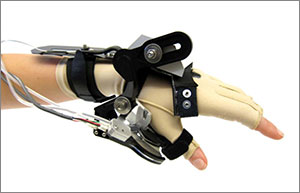
This child-sized device assists children with thumb movements while giving them sensory and visual feedback.
Our ability to use the thumb as an opposable digit is a critical part of what sets us apart as a species. “That’s how you’re holding a pen,” Leia Stirling, PhD, a senior staff engineer at the Wyss Institute for Biologically Inspired Engineering told me recently as we talked about the Wyss’ latest collaboration with Boston Children’s Hospital. “That’s how you hold your phone; that’s how you open a door; that’s what makes us unique.”
It’s also an ability that children who have suffered a stroke or have cerebral palsy or hemiplegia (paralysis on one side of the body) can lose or fail to develop in the first place.
Stirling, along with Hani Sallum, MS, and Annette Correia, OT, in Boston Children’s departments of Physical and Occupational Therapy, are the architects of a robotic device that may improve functional hand use. The device assists children with muscle movements, using small motors called “actuators” placed over the hand joints, while giving them sensory and visual feedback. It’s called the Isolated Orthosis for Thumb Actuation, or IOTA. Full story »

What will happen to medically complex children if insurance coverage is reduced and fewer pediatricians are trained to care for them? (Image: Wikimedia Commons)
Jay Berry, MD, MPH, is a pediatrician and hospitalist in the Complex Care Service at Boston Children’s Hospital. His most recent research appears in the JAMA Pediatrics, accompanied by editorials on the findings’ implications for health care and residency training. Berry further discusses its implications in this podcast.
My first encounter with a children’s hospital was as a first grader in 1980, when my 5-year-old cousin was diagnosed with cancer. Although her family was challenged to afford her cancer treatments, St. Jude Children’s Hospital in Memphis welcomed her and treated her cancer into remission. I remember my parents saying, “Everybody in that hospital loves children. No child is turned away.”
In 1997, walking into the Children’s Hospital of Alabama as a medical student, I felt the same sense of hope and courage. Everyone on the staff believed that they could make a difference in the lives of the children and families, despite the horrific illnesses that many of the children endured. I knew, immediately, that I wanted to become a pediatrician and to learn how to care for sick children. Full story »
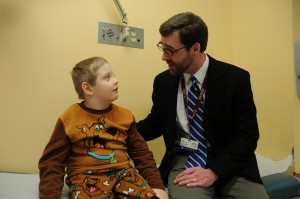
Many doctors feel unprepared to care for children with neurologic impairment. (Photo: Lindsey Hoshaw)
Jay Berry, MD, MPH, shown here with patient Kyler Quelch, is a pediatrician and hospitalist in the Complex Care Service at Children’s Hospital Boston. He leads the multi-institutional Complex Care Quality Improvement Research Collaborative.
As a general pediatrician, albeit one with experience in complex care, I find it extremely challenging to take care of children with neurologic impairment. A child’s nervous system can be “broken” for many reasons: a congenital brain or spinal cord malformation, severe head or neck trauma, a genetic condition or, like an increasing number of children, being born prematurely.
Most of the time, we can’t “fix” a broken nervous system. We can only try to support the body functions that are impaired as a result. Functions we take for granted: breathing, eating and digesting, moving, talking. We don’t have a lot of scientific evidence to guide us when doing this, Full story »

A sequence of motion frames of a normally kicking baby's legs (shown in blue and green), illustrating changing joint angles at the hip and knee.
Countless scientific epiphanies never leave the bench – unless there’s the kind of serendipitous encounter that set Children’s Hospital Boston psychologist Gene Goldfield on a path he never expected to follow.
One in eight babies are born prematurely, putting them at greater risk for cerebral palsy, an inability to fully control their muscles. Goldfield saw these children being wheeled around the hospital, and was convinced that they did not have to be wheelchair-bound.
During early infancy, he knew, the developing brain naturally undergoes a rewiring of its circuits, including those that control the muscles. Could some type of early intervention encourage more typical motor development by replacing damaged circuits with more functional connections?
At Children’s Innovators’ Forum last week, Goldfield discussed his envisioned solution: the use of programmable robots Full story »
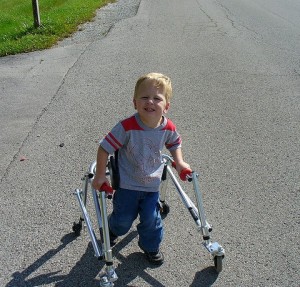
Children with severe cerebral palsy sometimes need surgery to help their hips and spine. But do these operations actually improve quality-of-life? Rachel DiFazio would like to know. (PaulEisenberg/Flickr)
Children with cerebral palsy (CP), the most common form of physical disability in children, all experience at least some difficulties in communication and movement. Those with the most severe forms of CP sometimes undergo reconstructive surgery on their hips and spine to correct dislocations or scoliosis. But do these operations actually improve quality of life?
“I’ve taken care of children with cerebral palsy for 21 years, and I’ve always wondered what the outcomes were of the surgeries,” says Rachel DiFazio, a nurse practitioner with the CP Program at Children’s Hospital Boston. “We have a lot of X-ray data and range-of-motion data, but we don’t really know if it gets any easier to take care of these children, whether life gets a little bit easier after the surgery, and in what ways.” Full story »
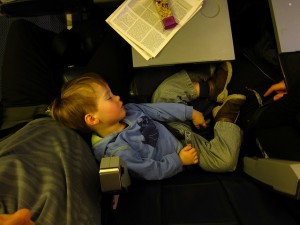
Photo: Lars Plougmann/Flickr
Jay Berry, MD, MPH, is a pediatrician and hospitalist in the Complex Care Service at Children’s Hospital Boston. He leads the multi-institutional Complex Care Quality Improvement Research Collaborative (CC-QIRC). This post is first of a three-part series.
Everywhere you turn these days, there’s an airline, grocery store or coffee shop pushing a “frequent flyer” or “rewards” program. You know the gist – the more money you give these businesses, the more discounts they give back to you and the more money you “save.” In theory, these programs are win-win: customers like frequenting the same business; businesses love holding onto satisfied customers.
But when I was a medical student, and overheard a nurse call my patient a “frequent flyer,” I wondered, “Who gets the ‘reward’ in that frequent flyer deal?” I hoped this child, a 4-year-old boy with cerebral palsy, was benefiting from being admitted over and over again. Full story »
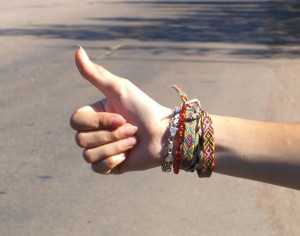 Move over, Ozzy Ozbourne. Next Wednesday, October 27th, Children’s neurologist-neuroscientist and TEDMED speaker Frances Jensen will compare and contrast the developing infant brain with the highly paradoxical teen brain – which is also developing rapidly, all the way to age 25 or so. Infant and teen brains are at opposite ends of the developmental spectrum — almost different species, Jensen says – but they’re both extremely dynamic and exquisitely sensitive to environmental factors (drugs and alcohol in teens and brain injury and seizures in infants). Full story »
Move over, Ozzy Ozbourne. Next Wednesday, October 27th, Children’s neurologist-neuroscientist and TEDMED speaker Frances Jensen will compare and contrast the developing infant brain with the highly paradoxical teen brain – which is also developing rapidly, all the way to age 25 or so. Infant and teen brains are at opposite ends of the developmental spectrum — almost different species, Jensen says – but they’re both extremely dynamic and exquisitely sensitive to environmental factors (drugs and alcohol in teens and brain injury and seizures in infants). Full story »
The seemingly random flailing of a newborn’s arms and legs is more important than it looks – it’s how babies begin to explore the physical world and their place in it. This motion-capture movie shows the normal kicking of a 5-month-old, but when a baby’s muscles are weakened by brain injury, this exploration is curtailed. It becomes a vicious cycle: the motor parts of the brain can’t develop properly, impairing mobility even further. Psychologist Eugene Goldfield, PhD, of the Center for Behavioral Science at Children’s Hospital Boston, with a team of engineers and scientists at the Wyss Institute, is in the early stages of a project that could help break this cycle for babies with cerebral palsy.
Goldfield calls it the “second skin” – smart clothing whose fabric, studded with tiny sensors, would pick up attempts at motion. Full story »
Infant kicking data being captured for the "second skin"
Two or three years ago, seeing all the children in wheelchairs coming to Children’s Hospital, I asked myself whether I might be able to contribute something tangible to help restore their mobility. A psychologist by training, I had published some academic articles on how young children become independently mobile. But I’ve also always liked to build things.
It became clear that anything I wanted to build would require skills I didn’t have. I envisioned a form-fitting, electronic garment that a child with a brain injury could wear to assist his or her biological muscles, teaching the brain how the body should move. How on earth could I get the money to build such a garment, and who could help me? Full story »














